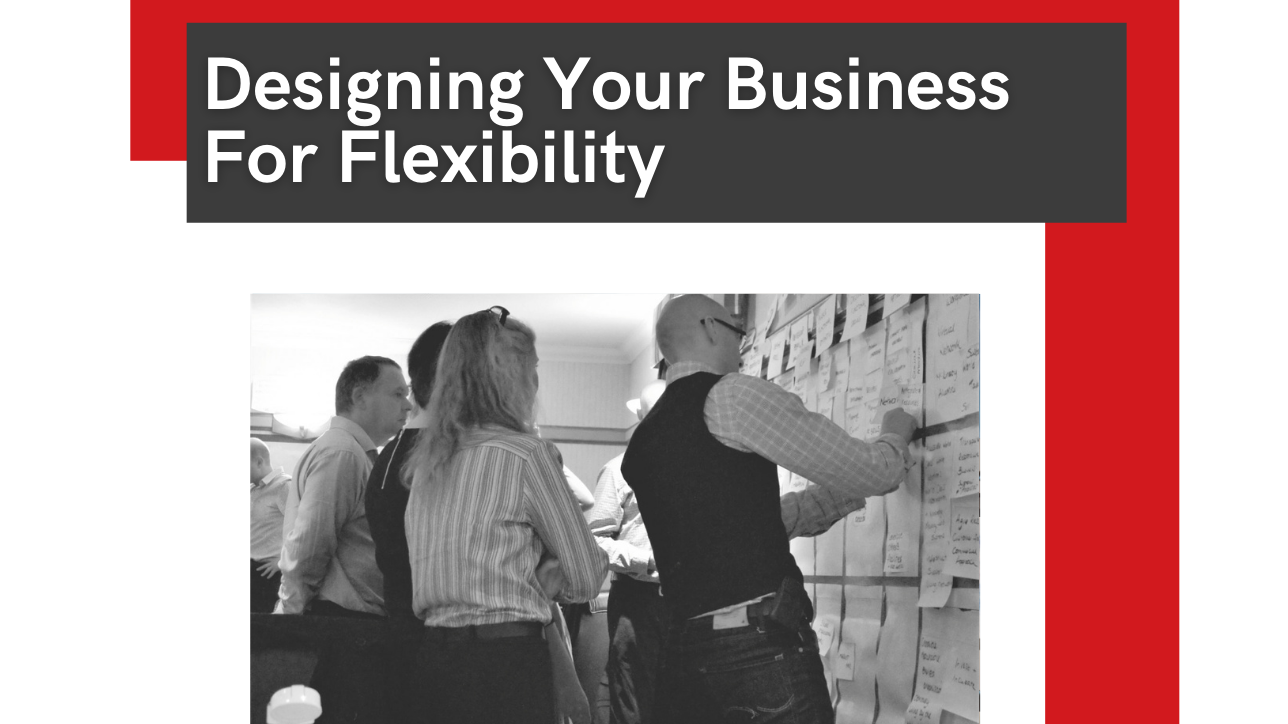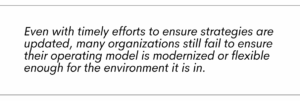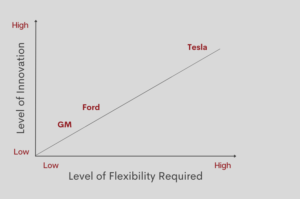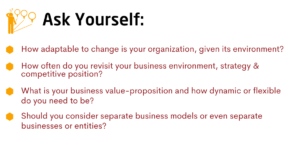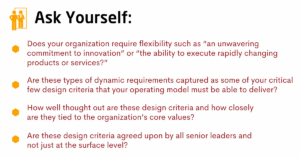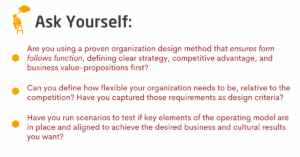7 minute read
Takeaway: If your business is facing disruptive change or is in a dynamic business environment, your strategies will change more often too. Determining your strategy and how dynamic or disruptive your organization needs to be is the first step towards determining how flexible your operating model must be. Design your business for flexibility with these three steps…
Inspiration from the Organization Design Forum (ODF) Conference
After reconnecting with my organization design tribe at the annual ODF conference, presenter Stu Winby caught my attention in his keynote presentation. He made a provocative statement about the state of organization design work being done today.
Stu proposed there was a gap between the technology innovation taking place in businesses and the lack of innovation in how organization design is practiced. He also shared how the amount of innovation taking place was expediting an organization’s life-cycle journey, or journeys. Stu lives and works near Silicon Valley, so he has exposure to some of the most dynamic organizations in the world. Still, even if your organization is not considered as dynamic as some of those near Palo Alto, the technology changes and the impact on the customer experience, information sharing, and decision-making cannot be ignored.
Here are some exact quotes from Stu’s presentation:
- Historically, organization design was periodic, resulting in a configuration that degraded over time
- Now, organization design must be continuous and dynamic
- Strategy and goals are temporary in order to respond to a changing environment, therefore, strategy and design must adapt simultaneously
- Digital technologies that enable new capabilities are a key cause of this
As a leader of your organization or as a designer of operating models, how much flexibility must your operating model enable, given its business direction and strategic drivers? How often do you need to assess how fit for purpose your operating model is? Following are some thoughts on what you can do and some questions to consider. I would love to hear your feedback. Any other suggestions? Do these three steps listed below seem useful?
ON THE MARK’s Point of View
If your business is facing disruptive change or is in a dynamic business environment, your strategies will change more often too.
To illustrate this point, consider a continuum of organizations and how innovative or dynamic they might need to be and how they operate. Tesla, for instance, would be seen as an organization that has been more dynamic than General Motors or Ford, thus at the highly innovative end.
Where on the continuum is your organization, based on where you want to play and how you will win? Determining your strategy and how dynamic or disruptive your organization needs to be is the first step towards determining how flexible your operating model must be.
Any good approach to organization design should emphasize having an operating model that is fit for purpose or aligned with the strategy. Truly dynamic organizations must be able to learn fast and be better prepared for proactively taking strategic actions than their competition. This requires flexible operating models, including flexible reconfiguration of work and processes, flexible structures, systems and management mechanisms, flexible rewards, and little tolerance for anything that gets in the way of the desired climate and culture.
Hiring people with the desired skills and mindsets is important, yet not sufficient nor sustainable without the right environment. Many companies are facing more dynamic business situations and technology changes that are significantly changing how information is used to make decisions, so even if you do not work for Tesla, it is important to consider how flexible your organization needs to be and design it with the desired culture in mind too. Operating in a fast-paced, rapidly changing business environment and having to adjust an operating model more often, also requires an eyes-wide-open perspective on what it will be like to work for that type of an organization.
If you are wondering how flexible your organization needs to be, consider these three steps:
Three Steps to Design for Flexibility:
Step 1: Consider How Dynamic Your Business Environment or Situation Really Is
At OTM, we do not even consider doing operating model redesign work until the business direction is clear and there is aligned leadership direction for what will differentiate the organization from others. Depending upon the business environment, these deliberations may need to happen more often, requiring much greater agility and flexibility to respond and make operating model changes too.
Is your organization more like Tesla or more like a traditional automobile manufacturer, albeit most of them are trying to innovate too? Tesla’s overall vision is “To accelerate the world’s transition to sustainable energy.” A related vision statement for their vehicle division is “To create the most compelling car company of the 21st century by driving the world’s transition to electric vehicles.”
Is there any question whether this is Tesla’s vision? Compared with other more traditional automotive manufacturer’s vision statements, there is a difference.
Harley-Davidson (H-D), which has been around since 1903, is experiencing a more dynamic business environment requiring a significant shift. H-D just spun off its Livewire division (electric motorcycle) as a separate company, headquartered in California, not Milwaukee, WI. This latest move demonstrates how different the strategic environment is for this part of the business, justifying an operating model choice that is surely more flexible than the existing one for core products. Some organizations can operate in a more ambidextrous way, having two different business models or perhaps balancing their core business with more innovative ventures.
This often proves challenging however, so an honest assessment, looking at the value customers expect from you and considering your most value-added whole work, end-to-end, will help determine whether being able to operate more ambidextrously or not is something you need to consider.
Step 2: Determine how flexible your operating model needs to be
Every business has core, differentiating work and capabilities that will distinguish themselves from the competition. If being innovative or having the organizational agility to respond to dynamic environments is truly a requirement for competitive advantage, you should strive for nothing short of that. Tesla makes it noticeably clear to their employees, that to be successful, you will innovate. Just trying to copy Tesla and state the same expectations or values is not enough and will not be seen as authentic by your organization if not believable.
Tesla also has more dynamic or flexible core capabilities because of where they are in their organization’s lifecycle. All organizations are more naturally innovative when just beginning. Rivian and Lucid Motors are similar, whereby more traditional automotive manufacturers will have to consider whether they keep their disruptor offerings in-house or take an approach more like H-D and spin them off. Some organizations may see a big bend in the organization lifecycle “s-curve” coming sooner than others and decide they can make a significant enough transformation to renew their entire organization. Ford seems to be going more this route. Time will tell if they saw it soon enough and more importantly, are able to renew their organization.
Many organizations OTM works with are reporting bends in their s-curve or changes to their business direction coming at a much faster pace, so anticipating those bends and being able to respond with more modern or aligned operating model choices must happen more dynamically as well. Having the ability to modernize your operating model more rapidly is a differentiator by itself.
Step 3: Assess How Flexible Your Operating Model Is and What Changes are Needed
At OTM, we often say, if your business situation and strategy are changing, your operating model must change too. Tesla creates competitive advantage by constantly assessing its business situation and strategy and will sometimes re-organize project teams on a weekly basis, maybe even faster! These are not necessarily full operating model changes, yet this environment requires a flexible operating model that is constantly aligning. If captured, the strategic design criteria or requirements would promote learning, flexibility, and innovation as key to winning or a competitive advantage.
 In addition to identifying the most strategically critical work and key roles that provide the most value, you will also need an effective management operating system and integrating mechanisms such as program and project management, along with people policies and rewards that drive innovation. Whether explicit or not, Tesla seems to have the requirements of flexibility and driving innovation as part of their design criteria, imperative to guiding their operating model’s success. The more dynamic the business situation is, the more important it is for organizations to continually assess which capabilities are needed most and not over rely on a few just because they were critical for a certain time or situation.
In addition to identifying the most strategically critical work and key roles that provide the most value, you will also need an effective management operating system and integrating mechanisms such as program and project management, along with people policies and rewards that drive innovation. Whether explicit or not, Tesla seems to have the requirements of flexibility and driving innovation as part of their design criteria, imperative to guiding their operating model’s success. The more dynamic the business situation is, the more important it is for organizations to continually assess which capabilities are needed most and not over rely on a few just because they were critical for a certain time or situation.
Conclusion
Regardless of how dynamic your business environment or strategy may be, applying these three steps provides a proven way to future proof your organization and ensure optimal performance and flexibility. OTM builds the discipline of conducting fit-for-purpose reviews into the overall governance of the redesign. After a while, it becomes a way of leading and is expected.
One of the biggest challenges to modernizing an operating model is getting the right people together at the right time to have honest conversations, so they can see the whole, not just their part. OTM believes how this work is done is as important as the answers themselves. With thoughtful and timely strategy clarification complete, following a proven organization design method will ensure you are making the appropriate changes to your operating model and in an aligned way, versus just addressing isolated parts.
A comprehensive organization design approach will inform whether redesigning the organization is needed, versus merely restructuring or modifying some of the key elements. No matter the amount of disruption, just having a better understanding of what you are changing and why will improve your organization’s effectiveness and health.
Let’s Talk!
Mark Robinson is a Senior Consultant at ON THE MARK. OTM is a global leader in collaborative operating model modernization that creates real change, fast. OTM’s passion for collaborative business transformation is supported by pragmatism, systems thinking, and a belief in people that is unparalleled for 33 years.

